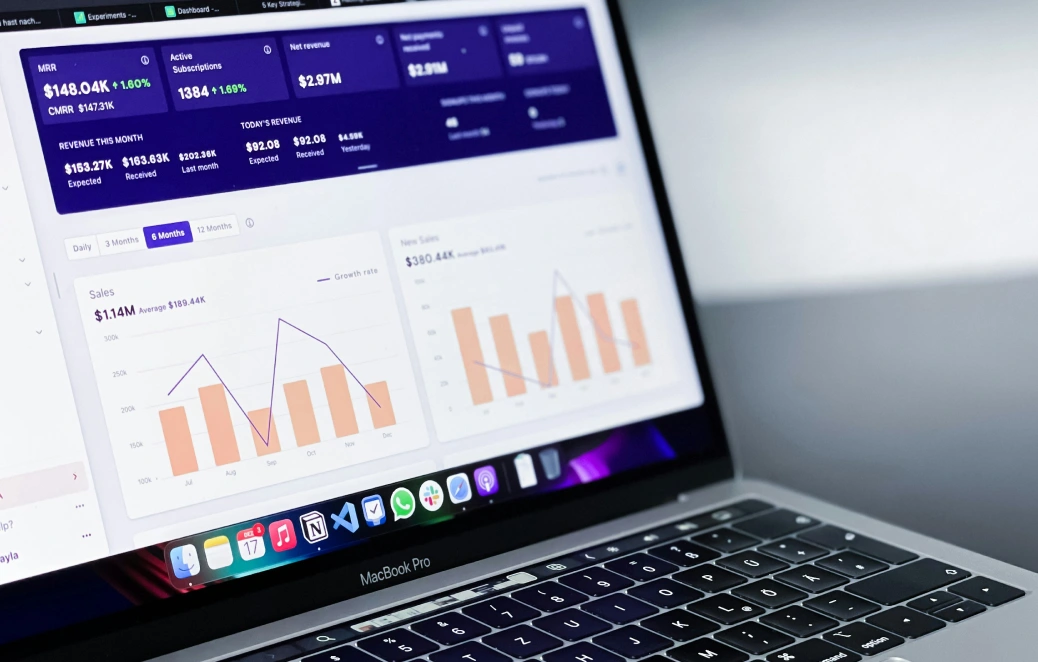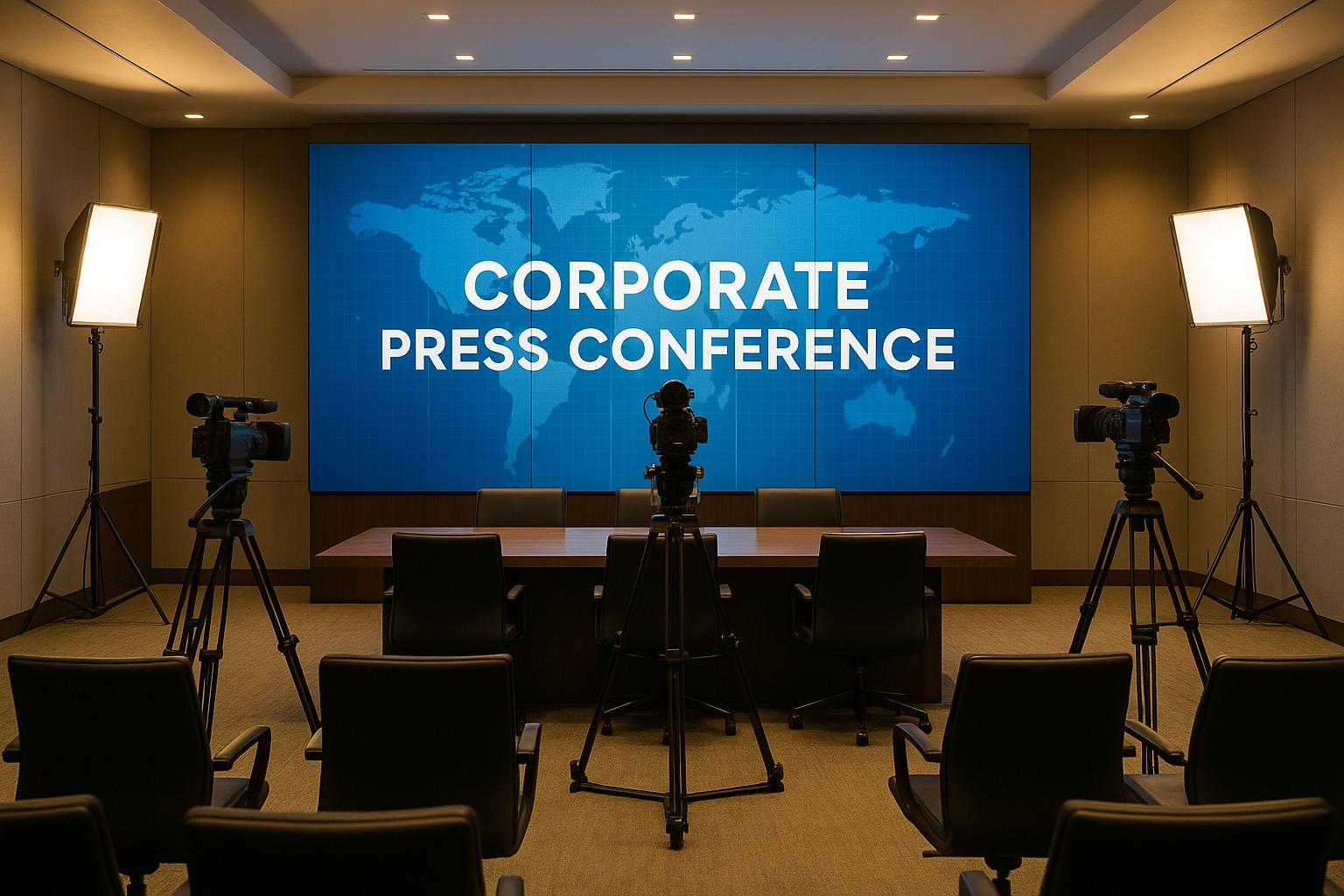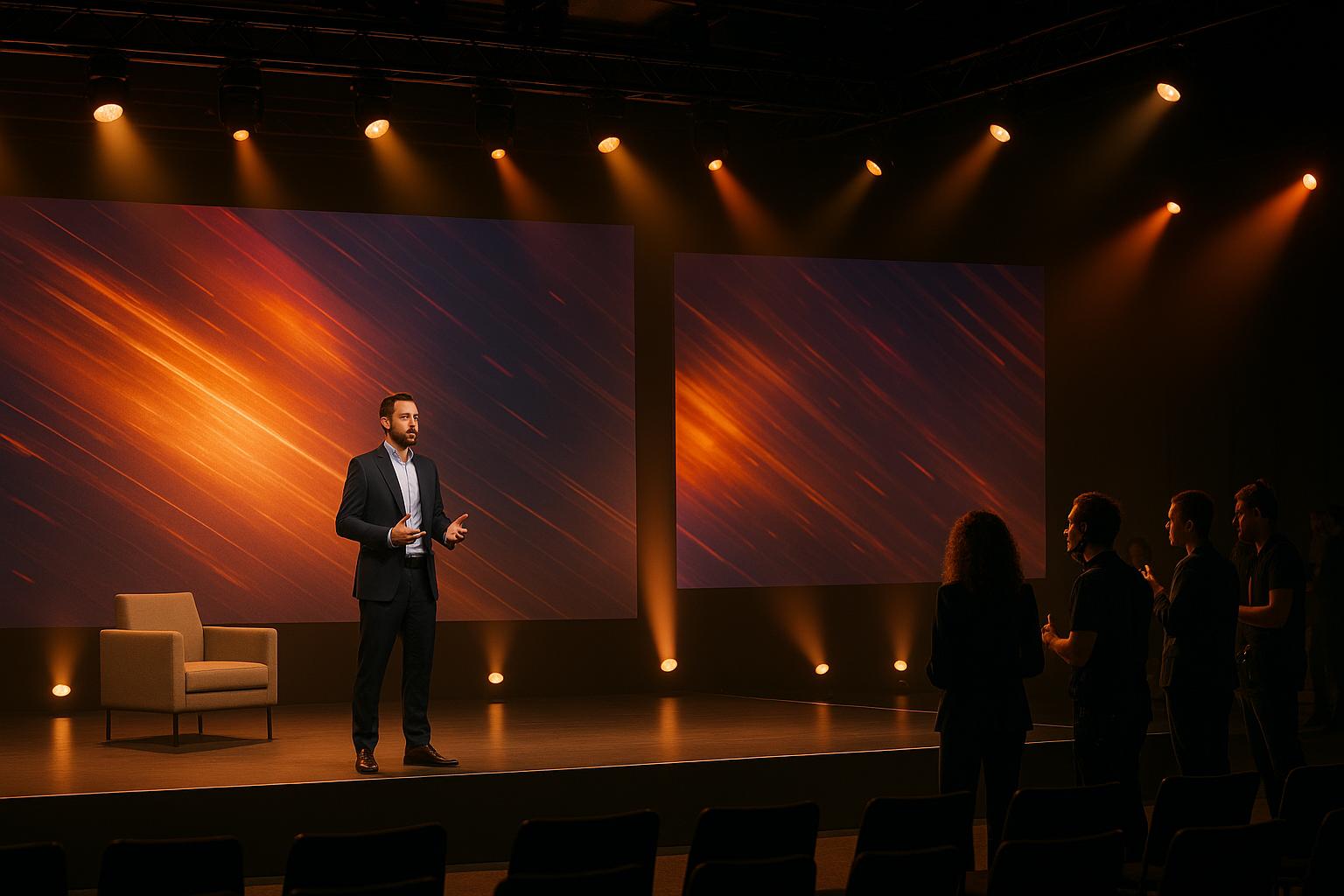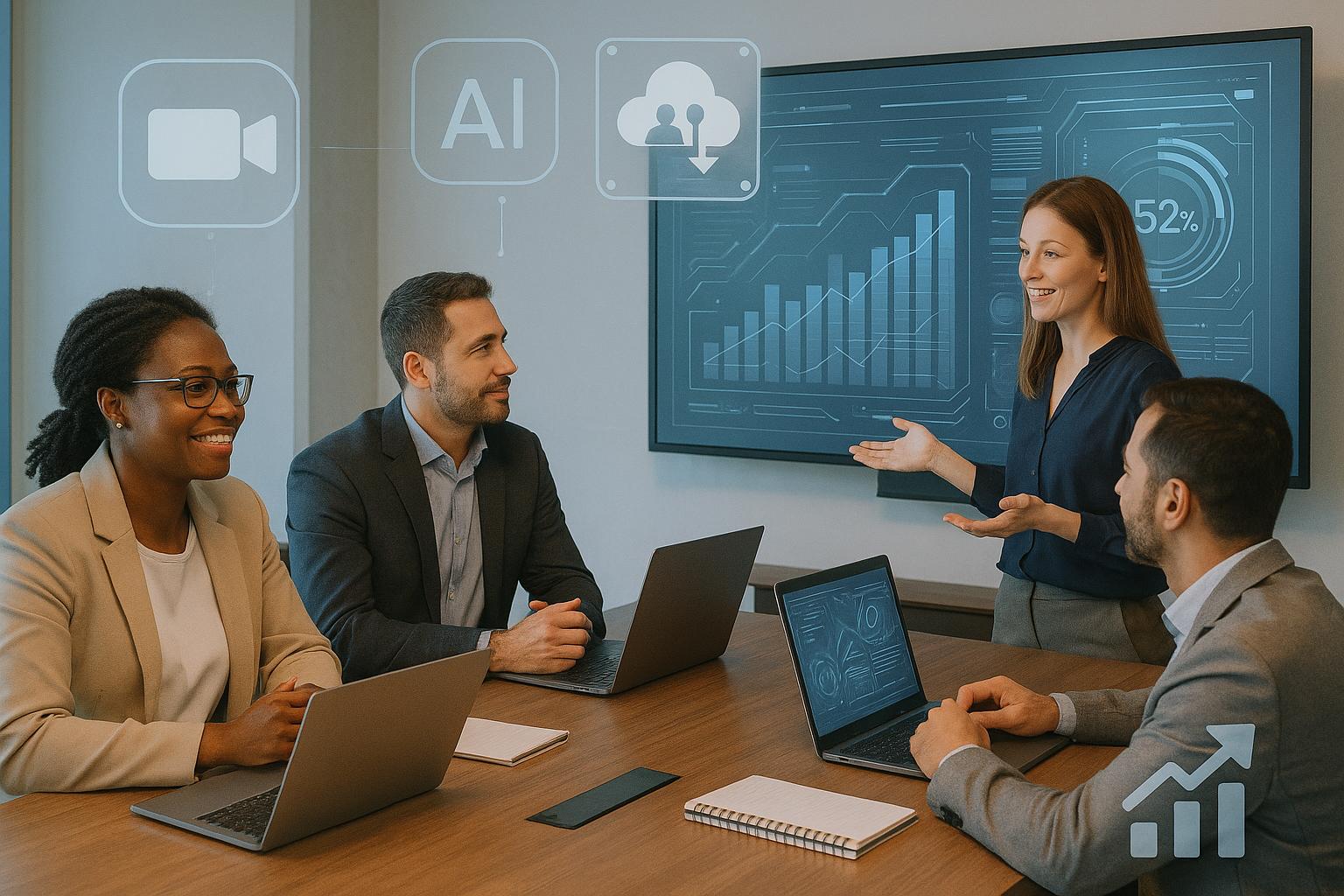Leading AI Solutions For Conference Production

Chief Executive Officer
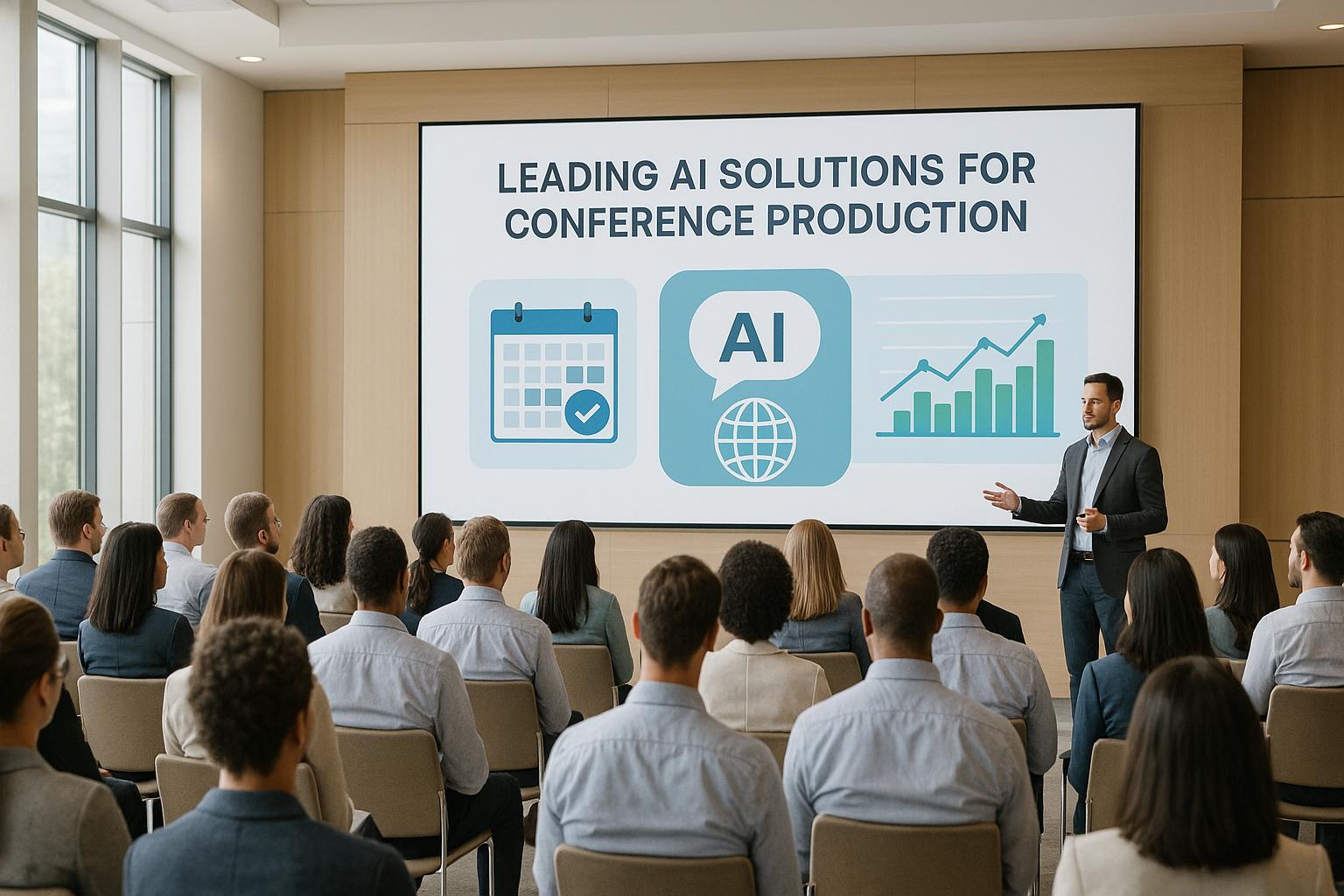
AI is changing how conferences are planned and run. From creating efficient schedules to automating audiovisual systems, these tools are making events smoother and more engaging for attendees.
Here’s what you need to know:
- AI Scheduling Tools: Automatically manage speaker times, room setups, and personalized attendee agendas. Great for avoiding conflicts but needs detailed data and struggles with last-minute changes.
- Real-Time Language Translation: Breaks language barriers with instant translations and live captions. However, it can miss technical terms or regional accents.
- Automated Audiovisual Systems: Monitors lighting and sound in real-time to maintain quality. Requires high initial investment and may lack flexibility in unexpected situations.
- Audience Engagement Platforms: Tracks attendee behavior, provides live feedback, and identifies popular topics. Useful for improving future events but requires careful data interpretation.
Key takeaway: These AI tools save time, improve attendee experiences, and reduce manual work. Start small with scheduling or engagement tools, then expand as your needs grow.
1. AI Event Scheduling Tools
Scheduling Optimization
AI-driven scheduling tools are transforming how event timelines and resources are managed. These platforms analyze factors like speaker availability, room capacities, and attendee preferences to create schedules that minimize conflicts and maximize engagement. They also allow for real-time updates, a must-have for live events where even small delays can throw everything off track.
One standout feature is their ability to automatically resolve scheduling conflicts. The system suggests alternative options and promptly notifies participants, keeping everything running smoothly.
Another game-changer? Personalized agendas. By leveraging attendee data, these tools can tailor schedules to match individual interests and professional objectives. This level of customization not only simplifies the planning process but also ensures a more seamless and enjoyable experience for everyone involved.
2. Real-Time Language Translation Solutions
Translation Accuracy and Accessibility
AI-driven translation tools are transforming the way we communicate across languages, especially in real-time. These systems can process spoken words and provide instant translations through mobile apps or live captions, making it easier for international audiences to engage and understand.
What’s more, they come with accessibility features like live captioning, which is a game-changer for attendees who are hearing-impaired. This ensures that events are more inclusive and welcoming for everyone. By enabling seamless multilingual communication, these tools are reshaping how conferences and events connect with diverse audiences, paving the way for even more advanced audiovisual technologies.
3. Automated Audiovisual Systems
AV Performance and Automation
AI-driven audiovisual systems are reshaping the way conferences are produced by fine-tuning performance on the fly. These systems actively monitor elements like lighting and acoustics, making real-time adjustments to maintain top-notch production quality. By processing live data, they help prevent disruptions during events, freeing up technical teams to concentrate on the creative and strategic aspects of the production. This kind of automated oversight aligns with the advancements seen in AI scheduling and translation tools, creating a seamless, fully automated event experience.
Much like AI tools for scheduling and language translation, these AV systems simplify operations while enhancing the overall event quality. They ensure that the technical side of things works hand-in-hand with the broader event goals, making everything run more smoothly.
4. Audience Engagement and Analytics Platforms
Engagement Depth and Data Insights
AI is reshaping how conferences connect with their audiences, going far beyond traditional feedback forms. These systems now analyze real-time behavior, tracking engagement patterns to deliver actionable insights that can shape future events. It’s not just about gathering data - it’s about understanding it to make smarter decisions.
Modern engagement platforms use machine learning to monitor interactions during sessions, Q&A discussions, and even across social media. They track attendance rates, networking activity, and social mentions to paint a clear picture of attendee behavior. This provides event organizers with a detailed view of how participants engage throughout the conference.
These platforms also pinpoint peak engagement moments in presentations, highlighting which topics spark the most interest. Features like interactive polling and feedback tools adjust in real-time based on audience responses, even generating follow-up questions to dig deeper into attendees' opinions. This keeps the audience actively involved while giving organizers richer, more meaningful feedback.
With sentiment analysis, AI takes things a step further by gauging audience mood and satisfaction. By analyzing text responses, social media activity, and even facial expressions captured through event apps, these systems can alert organizers to potential issues before they escalate. This proactive approach ensures a smoother event experience and allows for quick adjustments when needed.
AI-powered personalization tools also enhance the attendee experience. By analyzing individual preferences and behavior, these systems recommend relevant sessions and suggest networking opportunities tailored to each participant. After the event, detailed analytics reports break down engagement metrics by demographics and session types, helping organizers see what worked and where improvements are needed. This continuous learning process enables smarter planning and creates more satisfying experiences for future attendees.
sbb-itb-ae35a94
5 AI tools you need for your events
Pros and Cons
AI tools have transformed how conferences are organized and executed, but they come with their own set of trade-offs. Each tool offers distinct advantages and challenges that event planners need to weigh carefully based on their goals and budget.
AI Event Scheduling Tools are fantastic for avoiding scheduling conflicts and making the most of available spaces. However, they demand a significant amount of upfront data and often struggle with last-minute changes that call for human intuition. These tools thrive on consistent historical data, which means they aren't as effective for first-time events or unconventional formats.
Real-Time Language Translation Solutions make global communication easier by bridging language gaps. Yet, they often stumble when dealing with technical terms, regional accents, or subtle cultural nuances. While these tools enable multilingual interaction, they can miss context-specific meanings that a skilled human interpreter would pick up.
Automated Audiovisual Systems ensure steady quality and help cut staffing costs. That said, they require a hefty initial investment and are best suited for controlled environments. When unexpected technical glitches occur, these systems may lack the adaptability that human troubleshooting provides.
Audience Engagement and Analytics Platforms offer deep insights into attendee behavior and allow for real-time adjustments during events. The challenge lies in interpreting the data effectively and ensuring that the human element - which makes events memorable - isn't overshadowed by numbers.
| AI Solution | Key Strengths | Main Limitations | Best Use Cases |
|---|---|---|---|
| Event Scheduling | Resolves conflicts, optimizes resources | Needs extensive data input, struggles with changes | Large conferences with multiple tracks, recurring events |
| Language Translation | Enables real-time global communication | Misses cultural nuances, struggles with jargon | International conferences, diverse audiences |
| Automated AV | Consistent quality, reduces labor costs | High upfront costs, limited flexibility | Corporate presentations, standardized formats |
| Engagement Analytics | Offers behavioral insights, real-time feedback | Data overload, requires skillful interpretation | Large-scale events, audience research, planning |
When used thoughtfully, AI tools can greatly enhance event management. The key is to integrate them in ways that complement human expertise, ensuring smooth operations and a better experience for attendees.
For example, scheduling and engagement tools are often easier to implement, with subscription costs ranging from $100 to $9,999 per month. In contrast, automated AV systems demand a larger upfront investment and specialized setup. Event organizers should carefully weigh both the direct costs and the time needed for integration when deciding which tools to adopt.
Conclusion
AI-powered tools for conference production have transitioned from experimental concepts to practical solutions that many businesses now rely on. These tools, particularly those focused on event scheduling and audience engagement, have proven especially useful for organizations managing several events throughout the year.
For event producers in the U.S., starting with scheduling and engagement tools is a smart move. Opting for flexible subscription plans allows gradual scaling as needs grow.
Real-time translation tools are another game-changer, enabling seamless global communication while reducing interpreter costs. However, they can sometimes struggle with technical jargon, which may require additional support.
On the other hand, automated audiovisual systems require a considerable upfront investment and can be complex to set up. They are best suited for organizations that host standardized events and have dedicated technical teams to manage the process.
These varying requirements highlight the importance of a balanced approach. The key to success with AI in conference production lies in using high-quality data and ensuring expert oversight. Organizations that keep detailed event records and prioritize staff training often see significant gains in efficiency and improved attendee experiences. Ultimately, AI works best as a tool to enhance human decision-making, not as a replacement for it.
FAQs
How do AI scheduling tools manage unexpected changes during a conference?
AI scheduling tools are built to handle unexpected changes with ease, offering real-time adjustments that keep everything on track. Whether it's rescheduling sessions, reallocating resources, or sending out instant notifications, these tools ensure events stay organized with minimal disruption.
By analyzing situations and making decisions automatically, they eliminate the need for constant manual intervention. This means organizers can focus on the bigger picture while attendees enjoy a smooth, hassle-free experience - even when last-minute changes pop up.
How can the accuracy of AI-powered real-time language translation be improved for conferences?
Improving the precision of AI-driven real-time language translation at conferences hinges on a few essential strategies. One crucial step is training the AI with context-specific data and expertise in the relevant subject matter. This approach helps the system grasp industry-specific terminology, cultural subtleties, and idiomatic expressions, resulting in translations that are both accurate and meaningful.
On top of that, leveraging neural machine translation (NMT) technologies and deep learning algorithms can greatly enhance the AI's ability to navigate complex linguistic nuances, such as regional accents and dialects. Keeping the AI models updated and regularly training them with real-world scenarios ensures they stay sharp and effective, even in dynamic, live environments.
By implementing these strategies, conferences can deliver smooth and precise multilingual communication, creating a more engaging and inclusive experience for attendees.
What should I consider before investing in automated audiovisual systems for event production?
When you're weighing the decision to invest in automated audiovisual (AV) systems for event production, it’s important to start with the scale and complexity of your events. Automation can make it much easier to handle multiple AV components - like lighting, sound, and video - by ensuring everything works together smoothly and reducing the chances of technical hiccups.
Also, think about how automation can boost attendee engagement. With precise timing and seamless integration, automated systems can create immersive, synchronized AV experiences that leave a lasting impression and elevate the overall atmosphere of your event.
Finally, don’t overlook the cost benefits. Automation can help streamline operations, cut down on disruptions, and improve efficiency, all of which contribute to delivering a polished and memorable experience for your audience.
Related Blog Posts
